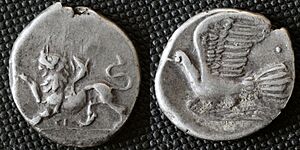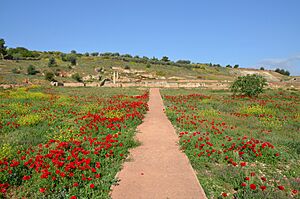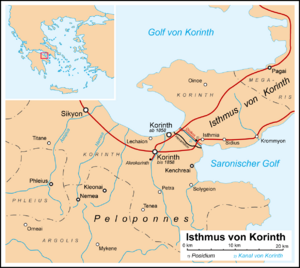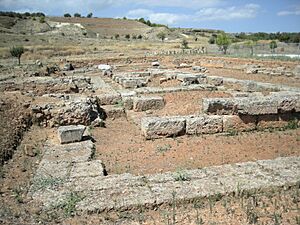Sicyon facts for kids
Sicyon (pronounced SISH-ee-on or SIK-yon) was an important ancient Greek city-state. It was located in the northern part of Peloponnesus, a large peninsula in Greece. Sicyon was situated between two other famous ancient cities, Corinth and Achaea. Today, you can find its ruins just west of the modern village called Sikyona.
Long ago, during the time of the Trojan War, Sicyon was ruled by kings. Later, it had leaders called tyrants, who were powerful rulers. In the 3rd century BC, it became a democracy, where people had a say in how the city was run. Sicyon was very famous for its amazing art. Many well-known painters and sculptors came from there. In later Greek times, it was also the home of Aratus of Sicyon, a key leader of the Achaean League, a group of Greek city-states.
Contents
Sicyon's Early History
The city of Sicyon was built on a low, flat area shaped like a triangle. This spot was about 3 kilometers (2 miles) from the Corinthian Gulf, which is part of the sea. Between the city and its port, there was a rich, flat land. This area was full of olive trees and fruit orchards.
During the Mycenaean period, Sicyon was ruled by a long line of mythical kings. According to ancient writers, there were 26 kings, followed by seven priests of the god Apollo. One famous list of kings starts with Aegialeus, who was believed to be the first ruler. Later, Agamemnon, a famous king from the Trojan War, made Sicyon part of his kingdom, Mycenae.
After the Dorian invasion, a group of people called the Dorians took over. Sicyon then became part of the kingdom of Argos. The people of Sicyon were divided into different groups. There were the Dorians and another group called the Ionians. There were also serfs, who were people who worked the land.
Sicyon's Tyrants and Allies
For a few centuries, Argos controlled Sicyon. But after 676 BC, Sicyon became independent again. It was ruled by a family of tyrants known as the Orthagorides. The first ruler was Orthagoras. The most important tyrant was his grandson, Cleisthenes. He ruled from 600 to 560 BC.
Cleisthenes changed the city's rules to help the Ionians. He also changed some of the city's religious practices, focusing more on the god Dionysus. Cleisthenes was also known for starting the First Sacred War (590 BC). He did this to help the people of Delphi.
Cleisthenes's successor, Aeschines, was removed from power by the Spartans in 556 BC. After this, Sicyon became an ally of the Spartans for over 100 years. During this time, Sicyon became famous for its crafts. It was known for its woodcarving and bronze work. You can still see examples of their metalwork at Olympia. Sicyon's pottery was also very popular and was sold far away in Etruria. People even believed that the art of painting was invented in Sicyon.
Sicyon in Major Wars
Sicyon was an important ally during the Persian Wars. In the Battle of Salamis, Sicyon sent fifteen warships. In the Battle of Plataea, they sent 3,000 soldiers. Sicyon was honored on the Delphic Serpent Column for its bravery. It was listed as the fifth most important city after Sparta, Athens, Corinth, and Tegea. In 479 BC, Sicyonian soldiers fought bravely in the Battle of Mycale. They lost more men than any other city in that battle.
Later, in the 5th century BC, Sicyon faced problems with Athens. Athens was a strong trading rival in the western seas. Athenian ships often bothered Sicyon. The Sicyonians fought two battles against the Athenians. One was against their admiral Tolmides in 455 BC. The other was a land battle against Pericles in 453 BC.
During the Peloponnesian War, Sicyon supported Sparta and Corinth. When Sparta and Corinth had a disagreement, Sicyon stayed loyal to Sparta. Later, during the Athenian expedition to Sicily, Sicyon sent 200 soldiers to help Syracuse. In the early 4th century, during the Corinthian war, Sicyon again sided with Sparta. It became Sparta's main base for operations against other allied cities near Corinth.
In 369 BC, the city of Thebes captured Sicyon. Thebans were attacking the Peloponnesian League. From 368 to 366 BC, a man named Euphron ruled Sicyon. He first supported democracy but then became a tyrant himself. Euphron was killed in Thebes by some Sicyonian nobles. But the people of Sicyon buried him in their hometown. They continued to honor him as if he were the city's second founder.
 |
|
| Front side: walking chimera; ΣΙ below | Back side: flying dove; pellet above |
| silver hemidrachm coin made in Sicyon 360–330 BC
ref.: BMC 124, Sear sg2774, SNG Cop. 64/65 |
|
Sicyon: A Center of Art
In the 4th century BC, Sicyon became a major center for art. Its school of painting was very famous under Eupompus. Great artists like Pamphilus and Apelles came to study there. Sculptors like Lysippus and his students made Sicyonian sculpture incredibly good. It was hard to find better art anywhere else in Greece.
The tyrant Aristratus, who was a friend of the Macedonian royal family, had his portrait painted. The painter Melanthius showed him with the goddess of victory, Nike, on a chariot. During this time, Sicyon was definitely the most important place for Greek painting. Famous artists from all over Greece came to its school.
In 323 BC, Euphron the Younger, a grandson of the earlier tyrant Euphron, brought democracy back to Sicyon. But the Macedonians quickly conquered the city during the Lamian War. In 314 BC, the Macedonian commander Alexander was killed in Sicyon. His wife, Cratesipolis, then took control of the city. She ruled for six years until King Ptolemy I convinced her to give it to the Egyptians. Between 308 and 303 BC, two Ptolemaic commanders, Cleonides and then Philip, ruled Sicyon.
The New Sicyon
In 303 BC, Demetrius Poliorcetes conquered Sicyon. He tore down the old city in the plain. Then, he built a new wall on the ruins of the old Acropolis, which was on the high triangular plateau. This new area was big enough for the smaller population. The new public meeting place, called the agora, had a "Painted Stoa." This building was named after Lamia, a flute player who was the king's girlfriend. For a short time, the town was called "Demetrias." But eventually, the old name, Sicyon, came back.
Demetrius left soldiers in the castle to control the city. Their commander, Cleon, started another tyrannical rule. After about 20 years, two rivals, Euthydemus and Timocleidas, killed him. They became the new joint tyrants of Sicyon. Their rule probably ended around 267 BC, when the people kicked them out. The people then chose their leader, Cleinias, to govern the city democratically.
One important thing the democratic government did was build a gymnasium. This building is believed to have been built by Cleinias. Around the same time, Xenokrates of Sicyon wrote a history of art. This book helped spread Sicyon's fame as a top center for ancient art.
The End of Sicyon's Independence
However, this time, democracy did not last long. In 264 BC, Cleinias was killed by his relative, Abantidas. Abantidas became a tyrant and ruled for 12 years. In 252 BC, two speakers, Aristotle the Dialectician and Deinias of Argos, murdered Abantidas. His father, Paseas, took over, but he was also murdered soon after by another rival named Nicocles.
In 251 BC, Aratus of Sicyon, who was Cleinias's 20-year-old son, attacked the city at night. He drove out the last tyrant. Aratus brought back democracy and allowed people who had been exiled to return. He also brought Sicyon into the Achaean League. This action stopped the fighting within the city. Aratus remained a leading figure in Achaean politics until he died in 213 BC. This was a time of great achievements for Sicyon. The city was peaceful and prosperous. The only interruptions were a raid by the Aetolians in 241 BC and an unsuccessful attack by King Cleomenes III of Sparta in 224 BC.
As a member of the Achaean League, Sicyon remained a stable democracy. This lasted until the Romans broke up the League in 146 BC. During this period, Sicyon was damaged by two bad earthquakes in 153 BC and 141 BC.
When Corinth was destroyed in 146 BC, Sicyon gained some land and the right to host the Isthmian games. But by the time of Cicero, a famous Roman speaker, Sicyon was deeply in debt. Under the Roman empire, it was overshadowed by the rebuilt cities of Corinth and Patrae. By the time Pausanias visited around 150 AD, Sicyon was almost empty.
In the 4th century BC, the people of Sicyon were the subject of a popular comedy by Menander called Sikyonioi.
William Shakespeare, in his 1606 play Antony and Cleopatra, mentions that Marc Antony's wife, Fulvia, died in Sicyon. Historically, she did die there in 40 BC while rebelling against Octavius Caesar.
Friedrich Hölderlin's novel Hyperion from 1797 begins in the "paradisiac plain of Sicyon."
Ancient Monuments of Sicyon
- Temple of Apollo or Artemis
- Theatre of Sikyon
- Palaestra - Gymnasium
- Stadium of Sikyon
- Bouleuterion of Sikyon (Council House)
Sicyon in the Middle Ages
During the early Middle Ages, Sicyon continued to decline. It became a place where a bishop lived. It also seems to have become a safe place for people escaping from Slavic groups settling in Greece during the 7th century.
After the Fourth Crusade, the settlement, then called Vasilika, came under the control of the Principality of Achaia. It became part of the prince's land. Prince William of Villehardouin (1246–1278) built a castle on top of the old ruined acropolis. This castle helped protect Corinth. By 1369, many villages near Vasilika were empty because of attacks by Turkish pirates.
Vasilika, along with Corinth, was bought by Niccolò Acciaioli from Florence. It then passed to Donato Acciaioli in 1362. Donato's son, Angelo Acciaioli, used Corinth and Vasilika as collateral for a loan from his cousin Nerio I Acciaioli by 1372. Nerio later became the Duke of Athens. When Nerio died in 1394, his daughter, Francesca Acciaioli, inherited Corinth and Vasilika. She had recently married Carlo I Tocco.
However, Nerio's other daughter, Bartolomea Acciaioli, and her husband, Despot Theodore I Palaiologos, argued about this. After a conflict, Francesca and Carlo only kept Vasilika and Megara. Corinth went to Despot Theodore. Finally, Despot Theodore II Palaiologos took Vasilika in 1427.
The Ottoman Turks invaded and took control of Corinth and Vasilika in 1458. This happened two years before they finished conquering the rest of the Morea in 1460–1461.
A village called Vasiliko until 1920 is next to the ancient and medieval site of Sicyon. The 1911 Encyclopædia Britannica described it as "insignificant." Today, it is named Sikyona, after the ancient city.
Mythical Rulers of Sicyon
Here are some of the mythical kings of Sicyon, mostly from ancient Greek and Roman writings:
- Aegialeus (believed to be the founder)
- Europs
- Telchis
- Apis of Sicyon
- Thelxion of Sicyon
- Aegyrus
- Thurimachus
- Leucippus
- Messapus
- Eratus
- Plemnaeus
- Orthopolis
- Marathonius or Coronus
- Marathus
- Echyreus or alternatively Coronus
- Corax
- Epopeus of Sicyon
- Lamedon
- Sicyon
- Polybus of Sicyon
- Inachus
- Phaestus
- Adrastus
- Zeuxippus of Sicyon
- Pelasgus
- Polypheides
After these kings, seven priests of Apollo Carneius ruled, according to ancient sources:
- Archelaus (ruled 1 year)
- Automedon (1 year)
- Theoclytus (4 years)
- Euneus (6 years)
- Theonomus (9 years)
- Amphigyes (12 years)
- Charidemus (1 year) - He left because he couldn't afford the costs. He was a priest 352 years before the first Olympic Games (around 1128 BCE).
Famous People from Sicyon
Ancient Times
- Aegialeus (21st century BC) - Legendary founder
- Tellis (8th century BC) - Runner (Olympic winner in 708 BC)
- Butades (7th century BC) - Sculptor
- Canachus (6th century BC) - Sculptor
- Aristocles (5th century BC) - Sculptor
- Praxilla (5th century BC) - Poet
- Ariphron (5th century BC) - Poet
- Alypus (5th to 4th century BC) - Sculptor
- Alexis (5th or 4th century BC) - Sculptor
- Eupompus (4th century BC) - Painter
- Pamphilus (4th century BC) - Painter
- Melanthius (4th century BC) - Painter
- Pausias (4th century BC) - Painter
- Eutychides (4th century BC) - Sculptor
- Lysippos (4th century BC) - Sculptor
- Lysistratus (4th century BC) - Sculptor
- Sostrates (4th century BC) - Pankratiast (won the Olympics three times)
- Canachus the Younger (4th century BC) - Sculptor
- Xenokrates (3rd century BC) - Sculptor and art historian
- Machon (3rd century BC) - Playwright
- Timanthes (3rd century BC) - Painter
- Nealkes (3rd century BC) - Painter
- Anaxandra (3rd century BC) - Painter
- Pythocles (3rd century BC) - Runner (Olympic winner in 236 BC)
- Aratus of Sicyon (271–213 BC) - Leader of the Achaean League
- Baccheidas - Dancer and music teacher
- Daetondas of Sicyon - Sculptor
- Bycelus - Olympic winner
Modern Times
- Sotirios Krokidas - Lawyer and Prime Minister
Sicyon and Mythology: The Trick at Mecone
Sicyon is often thought to be the same place as the mythical Mecone (or Mekone). This was the site of the famous "trick at Mecone" performed by the god Prometheus. In this story, Prometheus tricked Zeus during a sacrifice.
Mecone is also described by the poet Callimachus as "the seat of the gods." It was believed to be the place where the powerful gods Zeus, Poseidon, and Hades drew lots. They did this to decide which part of the world each of them would rule.
See also





